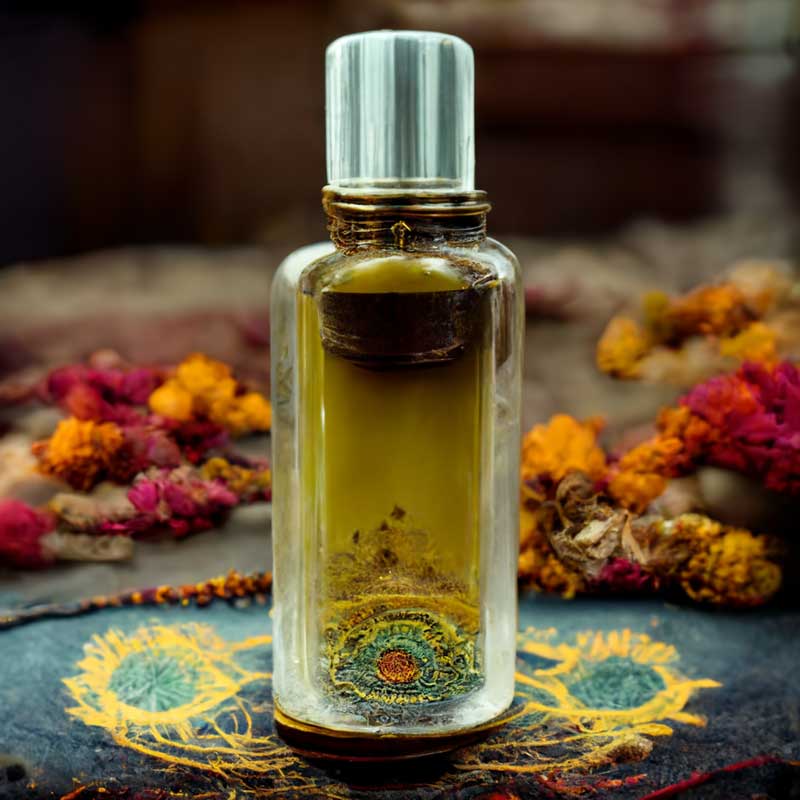Ayurvedic massage oil formula for Kapha dosha
This ayurvedic massage oil is particularly adapted to Kapha type people, who tend to accumulate toxins, to store water, to have a slow blood circulation, a skin which lacks tonicity and a certain frilosity.
The archetype of the Kapha dosha
Earth and water predominate in Kapha people.
In the Kapha dosha, the attributes unctuous, dense, firm, slow, stable, heavy, cold and viscous are predominant.
Kapha massage oil stimulates, tones and gives elasticity to the skin. Obesity, cellulite, high cholesterol and diabetes are Kapha dosha imbalances.
Since Kapha dosha is unctuous, a small amount of oil should be used. Since the cold attribute predominates, hot oil is used (but less than in the case of Vata).
Kapha people can be recognized by their thick, shiny skin and hair, which tend to become oily. They often have problems with weight gain and water retention. Cellulite is a Kapha dosha imbalance. So is depression and lethargy.

Most frequent indications for the application of Ayurvedic massage oil Kapha :
Oily and rough skin, dilated pores and excessive sebaceous secretion.
Blackheads and pimples. Common and cystic acne.
Lightening process.
Water retention or edema.
Late stages of cellulite, fibrous proliferation and scarring fibrosis.
Apathy, demotivation and states of lack of energy and indifference.
Ingredients of the ayurvedic massage oil Kapha :
Based on sesame oil, almond oil and mustard oil. Mustard oil is widely used in Ayurveda to treat Kapha dosha disorders. Mustard oil has antifungal and antibacterial properties, is rich in B vitamins, vitamin A and vitamin E, and contains folic acid, iron, magnesium, phosphorus and potassium. The oil of masssage ayurvedic Kapha contains the following natural assets:
- Lavandula officinalis : Diuretic. Affections of the respiratory tract, digestive, relieves headaches. Heals wounds. Relieves arthritic pain, bruises and sprains.
- Ocimum basilicum (Albnhaca, in Sanskrit Tulasi): Improves lipid metabolism (slimming) Revitalizing and tonic for the nervous system. Cleanses the respiratory tract. Reduces blood sugar levels. Contains ascorbic acid and carotenes, two antioxidants.
- Melia azadirachta (Neem): The oldest Ayurvedic medical texts refer to the benefits of Neem. Neem has antibacterial and antiviral properties. Significant blood sugar lowering effect. It is astringent and tonic The Neem leaf is famous in Ayurvedic texts for having magical properties on the skin. It is undoubtedly a biological treasure, which in itself constitutes an authentic and complete pharmacy. Neem has been declared by the United Nations as the "tree of the 21st century". It is a powerful antifungal, antiseptic and anti-inflammatory agent. Very effective in the treatment of acne, dandruff and eczema.
- Emblica officinalis (in Sanskrit, Amalaki or Amla): It has countless properties and has been used in Ayurveda for thousands of years. It is one of the great rejuvenating tonics of Ayurvedic medicine.
- Comniphora mukul (Sanskrit, Guggul): Used in Ayurveda for centuries for the treatment of rheumatism, obesity, hypothyroidism and urinary disorders. It maintains skin tone and reduces stretch marks. Guggul reduces blood cholesterol, decreasing low density lipoproteins and increasing high density lipoproteins.
- Terminalia chebula (Sanskrit: Haritaki): Rejuvenating thyme. Helps to eliminate fat and toxins from the body. In Ayurveda, it has been widely used to lower blood sugar levels.
- Zingiber officinale (Ginger, Sanskrit Shunti): The properties of this rhizorna are countless. Ginger is a digestive tonic and relieves gastrointestinal disorders. It improves the metabolism of lipids and is therefore slimming. It relieves respiratory disorders, colds and excess phlegm. It is attributed aphrodisiac properties.
Dosha Kapha: Characteristics of the Body and Mind
In this video discover what are the characteristics of a Kapha body and mind.
